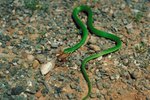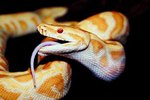
If you've never owned a snake, ball pythons can be an excellent choice. Mellow and low-maintenance, these West African serpents are common at pet stores and relatively inexpensive. Larger constrictors, such as Burmese and reticulated pythons, are better suited to experienced keepers, and they're illegal in some cities and states. Buying a python means committing to food, care and housing for 20 to 30 years -- and enjoying your intriguing, captivating pet.
Ball Pythons
Many breeders and hobbyists recommend ball pythons for novice owners. Available at most pet stores, these snakes tend to be gentle and non-aggressive; they curl into balls when they’re frightened, hence their name. Captive-bred animals usually are handled from the time they’re hatchlings so they become comfortable with human contact. Ball pythons’ relatively small size -- around 4 feet long for adults -- means their food and housing needs remain manageable and, compared to other python species, inexpensive. In addition, they pose less of a danger to humans and other pets than their larger, stronger relatives. In captivity, ball pythons can live 20 to 30 years, with the right housing, food and medical care.
Burmese Pythons
Widely available at pet stores and reptile shows, Burmese pythons often appeal to people who want a large snake. Unfortunately, these owners aren’t always prepared for the expense and hassle of an 18-foot, 200-pound pet, and many Burmese pythons end up in shelters or are euthanized. These snakes usually have good temperaments, especially if they’re handled regularly from the time they’re juveniles. They can be excellent pets for experienced snake-keepers with the resources to feed and house them.
Reticulated Pythons
Not for beginning snake-keepers, reticulated pythons reach lengths of 14 to 18 feet and can grow 5 feet or more during their first year. They tend to be more aggressive and unpredictable than ball pythons, even with regular handling, and can deliver nasty bites.
Tips
Many pythons in the pet trade have been caught in the wild and imported to the United States. Unfortunately, these snakes often adapt poorly to captivity, might refuse to eat, could have parasites and can be vulnerable to stress-related illnesses. In addition, over-collection for the pet trade has strained or threatened several species in the wild. It’s best to buy snakes that have been bred and born in captivity -- they usually feed better and are healthier. With the popularity of pythons as pets, there’s no shortage of reputable breeders.
It’s best to feed your python pre-killed rodents. Live mice and rats have sharp claws and teeth, and they can attack and even kill a snake.
Never handle a snake over 5 or 6 feet long by yourself. Large constrictors are extremely strong and can move very quickly. Even a usually docile snake with an experienced keeper can attack, especially if a feeding response is triggered.
References
- Chicago Exotics, PC: General Care of Ball Pythons: Susan Horton
- Avian and Exotic Animal Care: Reptiles: Ball Python Care Sheet
- Rainforest Adventures Discovery Zoo: Ball Python Pet Care
- Rainforest Adventures Discovery Zoo: Pet Reticulated Python Care
- Chicago Exotics, PC: Burmese Python: Erica Mede
- Purdue University College of Veterinary Medicine: Exotic Animal Medicine: Burmese Pythons -- Cool or Cruel? (PDF)
Photo Credits
-
Jupiterimages/Photos.com/Getty Images




